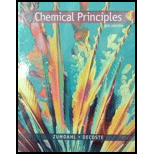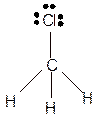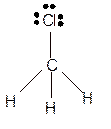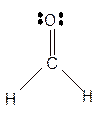
Concept explainers
(a)
Interpretation: The Lewis structure for HCN that obey the octet rule needs to be determined.
Concept Introduction:
Lewis dot structure is the representation which shows the bonding between atoms present in a molecule. It shows lone pairs and bond pairs that exist on each bonded atom. Lewis dot structure is also known as Lewis dot formula or electron dot structure.
The sum of valence electrons must be arranged in such a way that all atoms must get octet configuration (8 electrons).
(a)
Answer to Problem 63E

Explanation of Solution
The bond formation between the atoms takes place due to the sharing of valence electrons of bonded atoms while the remaining electrons present in outer shell represented as lone pair of electrons. To draw the Lewis structure, calculate the total number of valence electrons in each atom and draw the structure in such a way that each atom gets its octet configuration.
Total number of valence electrons in HCN:
Hence the best Lewis structure for HCN must be:

(b)
Interpretation: The Lewis structure for
Concept Introduction:
Lewis dot structure is the representation which shows the bonding between atoms present in a molecule. It shows lone pairs and bond pairs that existing on each bonded atom. Lewis dot structure is also known as Lewis dot formula or electron dot structure.
The sum of valence electrons must be arranged in such a way that all atoms must get octet configuration (8 electrons).
(b)
Answer to Problem 63E

Explanation of Solution
The bond formation between the atoms takes place due to the sharing of valence electrons of bonded atoms while the remaining electrons present in outer shell represented as lone pair of electrons. To draw the Lewis structure, calculate the total number of valence electrons in each atom and draw the structure in such a way that each atom gets its octet configuration.
Total number of valence electrons in
Hence the best Lewis structure for

(c)
Interpretation: The Lewis structure for
Concept Introduction:
Lewis dot structure is the representation which shows the bonding between atoms present in a molecule. It shows lone pairs and bond pairs that existing on each bonded atom. Lewis dot structure is also known as Lewis dot formula or electron dot structure.
The sum of valence electrons must be arranged in such a way that all atoms must get octet configuration (8 electrons).
(c)
Answer to Problem 63E

Explanation of Solution
The bond formation between the atoms takes place due to the sharing of valence electrons of bonded atoms while the remaining electrons present in outer shell represented as lone pair of electrons. To draw the Lewis structure, calculate the total number of valence electrons in each atom and draw the structure in such a way that each atom gets its octet configuration.
Total number of valence electrons in
Hence the best Lewis structure for

(d)
Interpretation: The Lewis structure for
Concept Introduction:
Lewis dot structure is the representation which shows the bonding between atoms present in a molecule. It shows lone pairs and bond pairs that existing on each bonded atom. Lewis dot structure is also known as Lewis dot formula or electron dot structure.
The sum of valence electrons must be arranged in such a way that all atoms must get octet configuration (8 electrons).
(d)
Answer to Problem 63E

Explanation of Solution
The bond formation between the atoms takes place due to the sharing of valence electrons of bonded atoms while the remaining electrons present in outer shell represented as lone pair of electrons. To draw the Lewis structure, calculate the total number of valence electrons in each atom and draw the structure in such a way that each atom gets its octet configuration.
Total number of valence electrons in
Hence the best Lewis structure for

(e)
Interpretation: The Lewis structure for
Concept Introduction:
Lewis dot structure is the representation which shows the bonding between atoms present in a molecule. It shows lone pairs and bond pairs that existing on each bonded atom. Lewis dot structure is also known as Lewis dot formula or electron dot structure.
The sum of valence electrons must be arranged in such a way that all atoms must get octet configuration (8 electrons).
(e)
Answer to Problem 63E

Explanation of Solution
The bond formation between the atoms takes place due to the sharing of valence electrons of bonded atoms while the remaining electrons present in outer shell represented as lone pair of electrons. To draw the Lewis structure, calculate the total number of valence electrons in each atom and draw the structure in such a way that each atom gets its octet configuration.
Total number of valence electrons in
Hence the best Lewis structure for

(f)
Interpretation: The Lewis structure for
Concept Introduction:
Lewis dot structure is the representation which shows the bonding between atoms present in a molecule. It shows lone pairs and bond pairs that existing on each bonded atom. Lewis dot structure is also known as Lewis dot formula or electron dot structure.
The sum of valence electrons must be arranged in such a way that all atoms must get octet configuration (8 electrons).
(f)
Answer to Problem 63E

Explanation of Solution
The bond formation between the atoms takes place due to the sharing of valence electrons of bonded atoms while the remaining electrons present in outer shell represented as lone pair of electrons. To draw the Lewis structure, calculate the total number of valence electrons in each atom and draw the structure in such a way that each atom gets its octet configuration.
Total number of valence electrons in
Hence the best Lewis structure for

(g)
Interpretation: The Lewis structure for
Concept Introduction:
Lewis dot structure is the representation which shows the bonding between atoms present in a molecule. It shows lone pairs and bond pairs that existing on each bonded atom. Lewis dot structure is also known as Lewis dot formula or electron dot structure.
The sum of valence electrons must be arranged in such a way that all atoms must get octet configuration (8 electrons).
(g)
Answer to Problem 63E

Explanation of Solution
The bond formation between the atoms takes place due to the sharing of valence electrons of bonded atoms while the remaining electrons present in outer shell represented as lone pair of electrons. To draw the Lewis structure, calculate the total number of valence electrons in each atom and draw the structure in such a way that each atom gets its octet configuration.
Total number of valence electrons in
Hence the best Lewis structure for

(h)
Interpretation: The Lewis structure for
Concept Introduction:
Lewis dot structure is the representation which shows the bonding between atoms present in a molecule. It shows lone pairs and bond pairs that existing on each bonded atom. Lewis dot structure is also known as Lewis dot formula or electron dot structure.
The sum of valence electrons must be arranged in such a way that all atoms must get octet configuration (8 electrons).
(h)
Answer to Problem 63E

Explanation of Solution
The bond formation between the atoms takes place due to the sharing of valence electrons of bonded atoms while the remaining electrons present in outer shell represented as lone pair of electrons. To draw the Lewis structure, calculate the total number of valence electrons in each atom and draw the structure in such a way that each atom gets its octet configuration.
Total number of valence electrons in
Hence the best Lewis structure for

(i)
Interpretation: The Lewis structure for
Concept Introduction:
Lewis dot structure is the representation which shows the bonding between atoms present in a molecule. It shows lone pairs and bond pairs that existing on each bonded atom. Lewis dot structure is also known as Lewis dot formula or electron dot structure.
The sum of valence electrons must be arranged in such a way that all atoms must get octet configuration (8 electrons).
(i)
Answer to Problem 63E

Explanation of Solution
The bond formation between the atoms takes place due to the sharing of valence electrons of bonded atoms while the remaining electrons present in outer shell represented as lone pair of electrons. To draw the Lewis structure, calculate the total number of valence electrons in each atom and draw the structure in such a way that each atom gets its octet configuration.
Total number of valence electrons in
Hence the best Lewis structure for

Want to see more full solutions like this?
Chapter 13 Solutions
CHEM.PRINC.W/OWL2+REBATE+2 SUPPL.>IP<
- The most common exceptions to the octet rule are compounds or ions with central atoms having more than eight electrons around them. PF5, SF4, CIF3, and Br3 are examples of this type of exception. Draw the Lewis structure for these compounds or ions. Which elements, when they have to, can have more than eight electrons around them? How is this rationalized?arrow_forwardWhat is meant by a chemical bond? Why do atoms form bonds with each other? Why do some elements exist as molecules in nature instead of as free atoms?arrow_forwardLewis structures can be used to understand why some molecules react in certain ways. Write the Lewis structures for the reactants and products in the reactions described below. a. Nitrogen dioxide dimerizes to produce dinitrogen tetroxide. b. Boron trihydride accepts a pair of electrons from ammonia, forming BH3NH3. Give a possible explanation for why these two reactions occur.arrow_forward
- G. N. Lewis developed a model for chemical bonding that you have learned in this chapter. His theory was extremely successful and is used today at all levels of chemistry, from the introductory class to the research laboratory. Why was Lewis theory so successful?arrow_forwardWrite Lewis structures for the following: (a) ClF3 (b) PCl5 (c) BF3 (d) PF6arrow_forwardWrite Lewis structures that obey the octet rule for each of the following molecules. a. CCl4 b. NCl3 c. SeCl2 d. ICl In each case, the atom listed first is the central atom.arrow_forward
- Draw the Lewis Structure for each covalent system a-e below, and answer the question that follows: Electronegativites: H = 2.1 C = 2.5, B = 2.0N = 3.0, 0 = 3.5 S = 2.5, F = 4.0, Xe = 2.6 a. (OF 2 )Is this molecular POLAR or NONPOLAR? b. (XeF2) What is the geometry of this molecule? c. (SO 3 ^ 2- )What is the polyatomic ion geometry? (Assume "S" obeys octet) d.( CH 2 F 2 )Is this molecular POLAR or NONPOLAR? e.( BF 3 )Is this molecular POLAR NONPOLARarrow_forwardWrite Lewis structures that obey the octet rule for each of the following molecules and ions. (In each case the first atom listed is the central atom.) a. POCl3, SO42-, XeO4, PO43-, ClO4- b. NF3, SO32-, PO33-.Cl3- c. ClO2-, SCl2, PCl2- d. Considering your answers to part a, b, and c, what conclusions can you draw concerning the structures of species containing the same number of atoms and the same number of valence electrons?arrow_forwardSubstance(s): H2CO, IF2-, O3, N2H4, NH4+, SCl4, NO2-, SO2, C2H2, Cl3PO, HCN, CF2H2, IF4-, XeF2, CI4, I3-, SeF6,H2O2, NF3, CS2. 1.Bonding groups 2.Number of lone pairs 3.Number of electron groups about the central atom 4.Number of resonance structures 5.Hybridization state about the central atom 6.Bond Angles 7.Polarityarrow_forward
- One type of exception to the octet rule are compounds with central atoms having fewer than eight electrons around them. BeH2 and BH3 are examples of this type of expectation. Draw the Lewis structures for BeH2 and BH3.arrow_forwardWhich statement is false given the following Lewis structures? Structure III is a valid structure for PF4 because P can expand its octet. Structure I is a valid structure for BBr3 because B (n=2) needs an octet of electrons. Structure II is a valid structure for SeH2 because H needs a duet of electrons. Structure IV is a valid structure for AsO43- because As can expand its octet.arrow_forwardThe standard heat of formation of BaBr2BaBr2 is −−764 kJ/molkJ/mol. The first ionization energy of BaBa is 503 kJ/molkJ/mol and its second ionization energy is 965 kJ/molkJ/mol. The heat of sublimation of Ba[Ba(s)→Ba(g)]Ba[Ba(s)→Ba(g)] is 175 kJ/molkJ/mol. The bond energy of Br2Br2 is 193 kJ/molkJ/mol, the heat of vaporization of Br2(l)Br2(l) is 31 kJ/molkJ/mol, and the electron affinity of BrBr is −−325 kJ/molkJ/mol. Calculate the lattice energy of BaBr2BaBr2.arrow_forward

 Chemistry: An Atoms First ApproachChemistryISBN:9781305079243Author:Steven S. Zumdahl, Susan A. ZumdahlPublisher:Cengage Learning
Chemistry: An Atoms First ApproachChemistryISBN:9781305079243Author:Steven S. Zumdahl, Susan A. ZumdahlPublisher:Cengage Learning ChemistryChemistryISBN:9781305957404Author:Steven S. Zumdahl, Susan A. Zumdahl, Donald J. DeCostePublisher:Cengage Learning
ChemistryChemistryISBN:9781305957404Author:Steven S. Zumdahl, Susan A. Zumdahl, Donald J. DeCostePublisher:Cengage Learning Introductory Chemistry: A FoundationChemistryISBN:9781337399425Author:Steven S. Zumdahl, Donald J. DeCostePublisher:Cengage Learning
Introductory Chemistry: A FoundationChemistryISBN:9781337399425Author:Steven S. Zumdahl, Donald J. DeCostePublisher:Cengage Learning World of Chemistry, 3rd editionChemistryISBN:9781133109655Author:Steven S. Zumdahl, Susan L. Zumdahl, Donald J. DeCostePublisher:Brooks / Cole / Cengage Learning
World of Chemistry, 3rd editionChemistryISBN:9781133109655Author:Steven S. Zumdahl, Susan L. Zumdahl, Donald J. DeCostePublisher:Brooks / Cole / Cengage Learning





